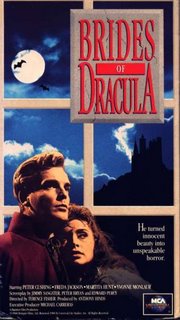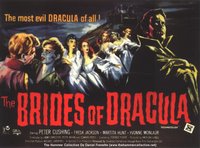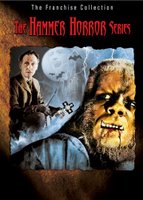
Director: Terence Fisher
Release Date: 1960
Contains spoilers
To some it might seem strange that this movie takes its place in the Dracula cycle of Hammer movies as, despite the title, Dracula is not in the film. This movie, however, is in direct sequel to Horror of Dracula (1958) and follows Van Helsing (Peter Cushing) as he continues his quest against the cult of vampirism. During the film a further titbit is revealed about this so called cult, letting us know that it is the remnants of pagan religion. It’s not a well thought out theory but it helps draw a dark shadowy world of the occult and supernatural around us by throwing common threads between stories that, by tying it into a cult, seem almost conspiratorial.
As I said, however, the obvious common thread – Dracula – is missing from this film, but his presence is certainly there, lurking like a dark heritage. He is mentioned in the opening voice over, “Count Dracula, monarch of all vampires, is dead. But his disciples live on, to spread the cult and corrupt the world...” Later his name is mentioned by Van Helsing in relation to bite marks upon a victim.
The film opens with a girl, Marianne (Yvonne Monlaur), travelling in a coach. The coach is stopped by a log across the road and, as it is moved by the driver, a stranger manages to secretly hitch on the back of the coach. Once the coach arrives at a village the man drops off before the girl alights, as she enters the inn he pays the coach-driver monies. The coach leaves, stranding the girl, and the innkeeper and his wife seem desperate for her to continue her journey, to the point of getting a cart to transport her.
However the Baroness Meinster (Martita Hunt) appears at the inn. It seems that Marianne is due to arrive at a girl’s academy the next day as a student teacher. The Baroness invites her to stay at her castle and promises to help her arrive at her new position, on time, the next day. A word here about the look of the film, it feels typically hammer, with the rich and vivid décor one would expect from the studio. Castle Meinster looks marvellous and is actually, in my opinion, a more fitting setting that the Count’s castle in the previous film.
Marianne spots a strange young man (David Peel) on the balcony of a room below hers. The Baroness tells her it is her son, and intimates that he is insane. In the night Marianne thinks he is going to jump from his balcony and goes to him. He is chained and weaves a tale about usurped inheritance, stating that he is the true Baron Meinster. Marianne helps him escape his bonds. Of course, he is a vampire and, upon escaping, kills his mother and escapes into the night. The maid, Greta (Freda Jackson), seems to have lost her mind completely and Marianne flees from the castle. In the morning she is found collapsed by Van Helsing - who was travelling to the region at invitation of the local priest, Father Stepnik (Fred Johnson). He rescues Marianne and takes her to the school.
It becomes apparent that Hammer decided to completely change their rules on vampirism here. Whilst the previous film stated that they could not transform into animal shape, here they can turn into bats (particularly rubbish looking bats at that). Bizarrely this change of rule is mentioned by Van Helsing, who told us in the previous film that vampires shape shifting was a common misconception, yet does not reference that he once believed it to be a fallacy. In his review, Exclamation Mark raises the more than valid point that, given this shape shifting ability, it seems unclear as to why the Baron did not escape his shackles earlier by turning into a bat. I can only assume that this was due to the fact they were silver, given the often used rule in genre movies that vampires are violently allergic to the metal – though this is just me being overly generous and I suspect it was actually a logical error on the part of the script writers.
The film has other problems. Marianne, later, becomes quickly engaged to Meinster, yet she seems to have forgotten that he ran off into the night, leaving her abandoned in his castle with the corpse of his mother. She also seems to have forgotten that Greta had shown her a coffin in his room with his imprint still in it, and indicated to her that he would return to it.  Okay so Greta was obviously mad, but you’d think Marianne might have had pause to thought. Peel himself is very good as Meinster but unfortunately carries none of the innate presence that Lee injected into the previous movie. Perhaps that is as well to a degree, after all he is a disciple of Dracula not the man himself, but somehow the lack of Lee caused the film to fall a little short. The criticism Peel received because he was a blonde vampire is, however, fairly puerile.
Okay so Greta was obviously mad, but you’d think Marianne might have had pause to thought. Peel himself is very good as Meinster but unfortunately carries none of the innate presence that Lee injected into the previous movie. Perhaps that is as well to a degree, after all he is a disciple of Dracula not the man himself, but somehow the lack of Lee caused the film to fall a little short. The criticism Peel received because he was a blonde vampire is, however, fairly puerile.
I guess I should also mention the local Doctor, Dr. Tobler (Miles Malleson), whilst I am citing problems. A comic relief character, the comedy falls more than a little flat and his presence is virtually unnecessary.
Yet the film has marvellous moments. The entire sub-story of the Baroness keeping her son hidden and luring young girls to feed his hunger is beautifully macabre and, given her reaction, once turned, is clearly a source of much anguish for the character, which offers a nice depth to the plot. Her actions seemed much underpinned by a combination of maternal instinct and guilt as she allowed him to fall into the crowd through which he became infected. The fact that Meinster turns her, rather than simply killing her, is disturbingly Oedipal in nature.
There is also a scene with Greta, now utterly mad as a hatter, talking a newly turned bride out of the earth. It is an effectively disturbing scene.
The most powerful scene, however, is when Van Helsing has been bitten by Meinster. On discovering the wounds Van Helsing heats a branding iron and brands his own neck, then pours holy water over the burnt flesh, causing both fang marks and brand to heal. We could question why the watching brides did not take advantage of the situation but, in truth, the performance by Cushing is so good through this sequence we can do naught but marvel at it. In fact, it has to be stated, that Cushing owns the movie, all other characters secondary to him.
The defeat of Meinster is fairly unique also. In a scene that outdoes the previous film and its crossed candlesticks, Van Helsing shifts the sails of a mill so that they cast the shadow of a cross across the fleeing vampire, holding and killing him. This was not meant to be the ending originally. In the first draft Dracula was to be summoned to dispatch him – an ending that would have been unsatisfying and illogical. The next re-write saw Meinster set to be destroyed by bats summoned by Van Helsing via an ancient manuscript. This was changed, some say, because it was feared that it would be deemed excessively violent by the censors and it was certainly too expensive to shoot at the time, but the ending was resurrected a couple of years later in Kiss of the Vampire (1962) a ‘miscellaneous vampire’ Hammer movie.
It is here, unfortunately, that we say farewell, for a while, to Cushing as Van Helsing – who will not pit wits against the Count and his undead disciples again until the film Dracula AD 1972 (1972).
Brides of Dracula is a rich, lush film that typifies (in many respects) the glory that is the Hammer studios. It does have flaws, as mentioned, but one wonders how much was due to the copious amount of rewriting the script went through; it ends up with four script writers credited. The place, however, where this losses marks, in my opinion, is in the lack of Lee – given that this was a Dracula series movie his presence is sorely missed and had it featured Lee or an actor who could match his authority, in the role of the villain, this might have been nearly perfect. As it is this is a strong 7.5 out of 10.
 At the time of review the film is unavailable in DVD format, in its own right, and is only part of “the Hammer Horror series” DVD set. This set, however, is a fantastic buy for Hammer fans, containing 8 films, including both this and “Kiss of the Vampire” (1962) plus 6 other none vampire Hammer movies.
At the time of review the film is unavailable in DVD format, in its own right, and is only part of “the Hammer Horror series” DVD set. This set, however, is a fantastic buy for Hammer fans, containing 8 films, including both this and “Kiss of the Vampire” (1962) plus 6 other none vampire Hammer movies.
The imdb page for Brides of Dracula is here.
Sunday, May 28, 2006
The Brides of Dracula - review
Subscribe to:
Post Comments (Atom)
















3 comments:
I like the silver shackles theory.
That's an interesting bit of history about the unused ending featuring a plague of bats (later to show up in Kiss of the Vampire). I did not know that.
Thanks Mark.
The silver is a bit of a stretch, it was probably an oversight... however silver is efinitely listed as a deterant much later in the cycle
It was this film that cemented Peter Cushing's Van Helsing as my all time favorite version of the character in any medium, even above Stoker's novel. Cushing plays the Professor as a kindly, soft-spoken academic, but then he goes full badass when vampires are around! The scene where he gets bitten and burns out the infection is very well done. That the unholy remnants of the pagan vampire cult are being wiped out by, essentially, a gentle bookworm seems fitting: modern science vs. ancient evil.
Post a Comment